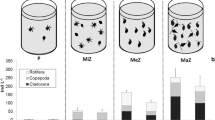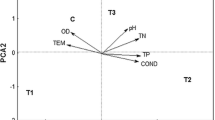Abstract
Zooplankton grazing impact on algae, heterotrophic flagellates and bacteria, as well as invertebrate predation on herbivorous zooplankton, were investigated in two sub-Antarctic lakes with extremely simple food chains. The two species of herbivorous zooplankton present in the lakes (the copepods boeckella michaelseni and Pseudoboeckella poppei) exerted substantial grazing pressure on algae. However, the dominant algal species exhibited properties that enabled them to avoid (large size or extruding spines, e.g. Staurastrum sp., Tribonema sp.) or compensate (recruitment from the sediment, Mallomonas sp.) grazing. There are only two potential invertebrate predators on the herbivorous copepods in the two lakes: the copepod Parabroteas sarsi and the diving beetle Lancetes claussi. Vertebrate predators are entirely abscent from sub-Antarctic lakes. Based on our experiments, we estimated that the predators would remove at most about 0.4% of the herbivorous copepods per day, whereas planktivorous fish, if present in the lakes, would have removed 5–17% of the zooplankton each day. Consequently, the invertebrate predators in these high-latitude lakes had only a marginal predation impact compared to the predation pressure on zooplankton in the presence of vertebrate predators in temperate lakes. The study of these simple systems with only two quantitatively functionally important trophic links, suggests that high grazing pressure foreces the algal community towards forms with grazer resistant adaptations such as large size, recruitment from another habitat, and grazer avoidance spines. We propose that due to such adaptations, predictions from food web theory are only partly corroborated, i.e. algal biomass actually increases with increasing productivity, although the grazer community is released from predation. In more species-rich and complex systems, e.g temperate lakes with three functionally important links, such adaptations are likely to be even more important, and, consequently, the observable effects of trophic interactions from top predators on lower trophic levels even more obscured.
Similar content being viewed by others
References
Azam F, Fenchel T, Field JG, Gray JS, Meyer-Reil LA, Thingstad F (1983) The ecological role of water-column microbes in the sea. Mar Ecol Prog Ser 10:257–263
Bottrell H, Duncan A, Gliwicz M, Grygierek E, Herzig A, Hillbricht-Ilkowska A, Kurasawa H, Larsson P, Weglenska T (1976) A review of some problems in zooplankton production studies. Norw J Zool 24:419–456
Carpenter SR, Kitchell JF (1987) The temporal scale of variance in limnetic primary production. Am Nat 129:417–433
Carpenter SR, Kitchell JF (1987) The trophic cascade in lakes (Cambridge studies in ecology). Cambridge University Press, Cambridge
Carpenter SR, Kitchell JF, Hodgson J, Cochran P, Elser J, Elser M, Lodge D, Kretchmer D, He X, Ende C von (1987) Regulation of lake primary productivity by food chain structure. Ecology 68:1863–1876
Crumpton W (1987) A simple and reliable method for making permanent mounts of phytoplankton for light and fluorescence microscopy. Limnol Oceanogr 32:1154–1159
DeMott W (1982) Feeding selectivities and relative ingestion rates of Daphnia and Bosmina. Limnol Oceanogr 27:518–527
Diehl S (1994) Relative consumer sizes and the strengths of direct and indirect interactions in omnivorous feeding relationships. Oikos 68:151–157
Ferguson A, Thompson J, Reynolds C (1982) Structure and dynamics of zooplankton communities maintained in closed systems, with special reference to the algal food supply. J Plankt Res 4:523–543
Fretwell S (1977) The regulation of plant communities by the food chains exploiting them. Perspect Biol Med 20:169–185
Giller PS, Gee JHR (1987) The analysis of community organization: the influence of equilibrium, scale and terminology. In: Gee JHR, Giller PS (eds) Organization of communities, past and present. Blackwell, Oxford, pp 519–542
Ginzburg L, Akçakaya R (1992) Consequences of ratio-dependent predation for steady-state properties of ecosystems. Ecology 73:1536–1543
Hairston N, Smith F, Slobodkin L (1960) Community structure, population control, and competition. Am Nat 94:421–425
Hanson J, Legget W (1982) Empirical prediction of fish biomass and yield. Can J Fish Aquat Sci 39:257–263
Hansson L-A (1992) The role of food chain composition and nutrient availability in shaping algal biomass development. Ecology 73:241–247
Hansson L-A (1993) Factors initiating algal life-form shift from sediment to water. Oecologia 94:286–294
Hansson L-A, Lindell M, Tranvik L (1993) Biomass distribution among trophic levels in lakes lacking vertebrate predators. Oikos 66:101–106
Hansson L-A, Rudstam LG, Johnson TB, Soranno P Allen Y (1994) Patterns in algal recruitment from sediment to water in a dimictic, eutrophic lake. Can J Fish Aquat Sci 51:2825–2833
Heywood R (1970a) Ecology of the fresh-water lakes of signy Island, South Orkney Islands. III. Biology of the copepod Pseudoboeckella silvestri Daday (Calanoida, Centropagidae). British Antarctic Survey Bulletin 23:1–17
Heywood R (1970b) The mouthparts and feeding habits of Parabroteas sarsi (Daday) and Pseudoboeckella silvestri, Daday (Copepoda, Calanoida). In: Holdgate M (ed) Antarctic ecology, vol. 2. Academic Press, London, pp 639–650
Jarvis A (1988) Diel zooplankton community feeding activity and filtration rates of Pseudoboeckella volucris and Daphniopsis studeri on sub-Antarctic Marion Island. Hydrobiologia 164:13–21
Jeppesen E, Sortkjær O, Søndergaard M, Erlandsen M (1992) Impact of a trophic cascade on heterotrophic bacterioplankton production in two shallow fish-manipulated lakes. Arch Hydrobiol Ergebn Limnol 37:299–231
Jespersen A-M, Christoffersen K (1987) Measurements of chlorophyll-a from phytoplankton using ethanol as extraction solvent. Arch Hydrobiol 109:445–454
Johansson L (1987) Experimental evidence for interactive habitat segregation between roach (Rutilus rutilus) and rudd (Scardinius erythropthalamus) in a shallow, eutrophic lake. Oecologia 73:21–27
Kerfoot WC, Levitan C, DeMott W (1988) Daphnia-phytoplankton interactions: density-dependent shifts in resource quality. Ecology 69:1806–1825
Lehman J (1980) Release and cycling of nutrients between planktonic algae and herbivores. Limnol Oceanogr 25:620–632
Lehman J, Sandgren C (1985) Species-specific rates of growth and grazing loss among freshwater algae. Limnol Oceanogr 30: 34–46
Lessmark O (1983) Competition between perch (Perca fluviatilis) and roach (Rutilus rutilus) in south Swedish lakes. Dissertation Lund University, Sweden
MacKay N, Carpenter SR, Soranno P, Vanni M (1990) The impact of two Chaoborus species on a zooplankton community. Can J Zool 68:981–985
Marker A, Nusch E, Rai H, Riemann B (1980) The measurement of photosynthetic pigments in freshwaters and standardization of methods: conclusions and recommendations Arch Hydrobiol Ergebn Limnol 14:91–106
Mazumder A (1994) Patterns of algal biomass in dominant oddvs. even-link ecosystems. Ecology 75:1141–1149
McQueen D, Post J, Mills E (1986) Trophic relationships in freshwater pelagic ecosystems. Can J Fish Aquat Sci 43:1571–1581
McQueen D, Johannes M, Post J (1989) Bottom-up and top-down impacts on freshwater pelagic community structure. Ecol Monogr 59:289–309
Nikolai V, Droste M (1984) The ecology of Lancetes claussi (Müller)(Coleoptera, Dytiscidae), the subantarctic water beetle of South Georgia. Polar Biol 3:39–44
Oksanen L, Fretwell S, Arruda J, Niemela P (1981) Exploitation ecosystems in gradients of primary productivity. Am Nat 118:240–261
Pace ML, Funke E (1991) Regulation of planktonic microbial communities by nutrients and herbivores. Ecology 72:904–914
Persson L, Andersson G, Hamrin S, Johansson L (1988) Predator regulation and primary production along the productivity gradient of temperate lake ecosystems. In: S. Carpenter (ed) complex interactions in lake communites. Springer, Berlin Heidelberg New York, pp 45–65
Porter KG (1975) Viable gut passage of gelatinous green algae ingested by Daphnia. Verh Internat Verein Limnol 19:2840–2850
Porter KG, Feig Y (1980) The use of DAPI for identifying and counting aquatic microflora. Limnol Oceanogr 25:943–948
Reynolds C (1984) The ecology of freshwater phytoplankton. (Cambridge studies in ecology). Cambridge University Press, Cambridge
Sherr EB, Sherr BE (1993) Preservation and storage of samples for enumeration of heterotrophic protists. In: Kemp PF, Sherr BE, Sherr EB, Cole JJ (eds) Handbook of methods in aquatic microbial ecology. Lewis, Boca Raton, pp 207–212
Sherr EB, Caron DA, Sherr BE (1993) Staining of heterotrophic protists for visualization via epifluorescence microscopy. In: Kemp PF, Sherr BE, Sherr EB, Cole JJ (eds) Handbook of methods in aquatic microbial ecology. Lewis, Boca Raton, pp 213–227
Strong D (1992) Are trophic cascades all wet? Differentiation and donor-control in speciose ecosystems. Ecology 73:747–754
Thompson J, Ferguson A, Reynolds C (1982) Natural filtration rates of zooplankton in a closed system: the derivation of a community grazing index. J Plankt Res 4:545–560
Wikner J, Hagström Å (1988) Evidence for a tightly coupled nanoplanktonic predator-prey link regulating the bacterivores in the marine environment. Mar Ecol Prog Ser 50:137–145
Author information
Authors and Affiliations
Corresponding author
Rights and permissions
About this article
Cite this article
Hansson, LA., Tranvik, L.J. Quantification of invertebrate predation and herbivory in food chains of low complexity. Oecologia 108, 542–551 (1996). https://doi.org/10.1007/BF00333732
Received:
Accepted:
Issue Date:
DOI: https://doi.org/10.1007/BF00333732




